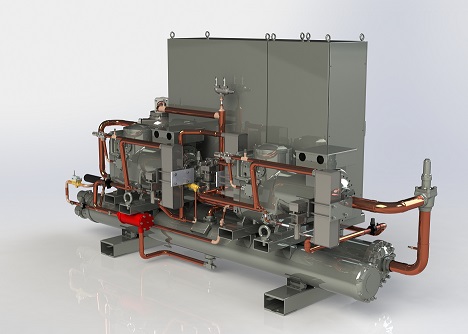Building Low Carbon Schools
ICAX supplied Interseasonal Heat Transfer to Howe Dell School in Hatfield and was involved in this project – to build a demonstration eco school – from inception.
Two of the directors of ICAX Ltd are CABE enablers for schools and have been involved in advising the UK government on construction of low carbon schools.
Everyone is now keen to construct new schools with a low carbon footprint and there are a number of different approaches that can be taken to reduce carbon consumption in new schools.
Energy Demands in Schools can be reduced by careful design
The main energy demands from schools come from winter heating, summer cooling and electricity for lighting and computing. Part of these demands can be reduced by constructing well insulated buildings, sensitive use of natural lighting and careful control of electric lighting, heating and ventilation. These techniques can also be used to provide a sense of space and contribute to a comfortable internal environment conducive to learning.
Solar thermal panels
Solar panels for providing hot water offer a well developed technology with a low capital cost and a low running costs, but schools do not generally need a high volume of hot water.
Biomass Boilers
Biomass boilers are considered for heating because of their low initial capital cost. However, such systems require management and regular maintenance. They need a good local supply of biomass fuel and can raise health and safely issues in the regular delivery of fuel to a school site. Because biomass boilers take time to heat up and cool down they are best suited to continuous operation: this is not a perfect match for schools which are not generally occupied in holidays, at weekends or even in the evenings.
A number of sustainability issues have also been raised recently in relation to using biofuels, so you will want to check that your source of fuel is local, reliable and not diverting resources from other sustainable objectives.
Biomass boilers are not able to contribute to the cooling needs that come with a well insulated modern building.

Ground Source Heat Pumps
Ground source heat pumps are used to provide heating. There will be higher initial capital costs than the standard solution of providing heat from a gas boiler – or an oil boiler where no piped gas is available – but a Ground Source Heat Pump will deliver the ongoing benefit of lower running costs, and income from the Renewable Heat Incentive. This derives from the ability of a heat pump to extract more heat from the ground than the electrical energy involved in doing so.
For existing schools high temperature heat pumps can be used in place of combustion boilers to provide the same temperature of water as is used in existing heat distribution systems: this avoids the need to reefurbish the existing heat distribution systems in the school.
Because budgets for capital projects in schools are always constrained, it can be helpful to look at fully funded options.
Overheating – Building Bulletin 101
There is, however, a potential difficulty inherent in providing a well insulated new building: a good design for retaining heat in winter can lead to excessive temperatures in summer – the examination season.
Recommendations from the Department for Education (Building Bulletin 101) require that the internal temperature in schools should never exceed 32°C and that there should be a maximum of only 120 hours a year where the temperature exceeds 28°C. There is also a need to hold internal temperatures to no more than 5°C above the external temperature. This forces many architects to consider air conditioning in spite of budgetary constraints and all the adverse implications for running costs and further carbon emissions.
Alternative approach – integrating renewables with thermal energy storage
There is, luckily, an alternative approach which can help both with heating in winter and cooling in summer. This involves using ThermalBanks to store heat from the time it is plentiful (in summer) to the time when heat is needed (in winter). Equally a ThermalBank can store cold when it is in abundant supply (in winter) to the time when it is needed (in exams). At last there is a renewable way – an affordable way – of providing cooling to schools in the exam season.

ThermalBanks are an integral part of an Interseasonal Heat Transfer system that can solve both winter heating needs and summer cooling needs – and do both with a low carbon footprint. Instead of solving each problem separately at a high carbon cost, Interseasonal Heat Transfer can solve both problems together. IHT balances the excess temperatures of each season with the extreme differences collected and stored from six months earlier.
IHT takes advantage of the merits of Heat Pumps to meet the needs of schools by performing a delicate temperature balancing act over the year, instead of fighting each need separately. This lateral approach saves money and saves carbon emissions.
IHT™ can save over 70% of carbon emissions compared to using a gas boiler for heating.
IHT™ can save over 80% of carbon emissions compared to using standard air conditioning and chillers for cooling.
Education for Sustainable Development
A further advantage of using Interseasonal Heat Transfer is exploited fully at Howe Dell School, where the building itself is used as an example of Education for Sustainable Development. See TES article. This is as a key part of the curriculum in teaching children to husband natural resources and respect the environment we live in. The children of Howe Dell were involved in and engaged in the design of their new school building from the start. Many of the materials used in its construction were locally sourced or make use of re-cycled materials. The Howe Dell eco-squad is very proud of the fact that its environmental principles have been extended to include the re-cycling of the heat in sunshine itself. ICAX provides sustainable energy to Howe Dell School.
Public Sector Decarbonisation Scheme
The Public Sector Decarbonisation Scheme can contribute to the costs of providing Renewable Heat and Interseasonal Heat Transfer.
See also: Hackbridge Primary School |Howe Dell School | Suffolk One Sixth Form College
See also: Renewable Heat | Renewable Cooling

